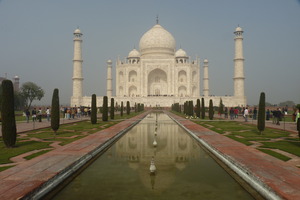The Mughal emperor, Shah Jahan is better known as the man who built the Taj Mahal. Although, it may be more accurate to say that the Taj Mahal was his idea. The story of the Taj Mahal is considered one of the most romantic stories in history. Shah Jahan had the palace built to commemorate his favorite wife, Mumtaz Mahal and today it stands as a symbol of his love. However, the Taj Mahal is not the only accomplishment that is attributed to this man, whose full name was Shahbuddin Mohammed Shah Jahan.
When Shah Jahan was born in Lahore on January 5, 1592, he was named Prince Khurram. He was the son of Emperor Johangir and his wife, Jaget Gosini. When the prince was 20 years old, he married the love of his life, Arjumand Banu Begum. Sixteen years later the prince began struggling for his father’s throne. In 1627, after a long struggle, the emperor died and Shah Jahan claimed the throne. The following year he became Emperor Shahbuddin Mohammed Shah Jahan.
After her husband became emperor, Arjumand Jaget Gosini was renamed Mumtaz Mahal meaning “ornament of the palace.” It is said that Shah Jahan loved her so much that he could not bear to be without her. He would supposeedly have her come with him when he rode out for battle. This apparently happened often, as Shah Jahan was attempting to expand his empire. His military campaigns were not especially noteworthy. However, he did meet with some success. His real passion lay in finery and beautiful architecture.
It is said that Shah Jahan adored jewels. It is, in fact, quite obvious that this is so. During his reign, the emperor had a throne built that was made largely out of gold and was fitted with diamonds, rubies, emeralds, and pearls. After Mumtaz died while giving birth to the couples fourteenth child, Shah Jahan built the Taj Mahal in her memory and had her laid to rest there. The palace was made out of stunning white marble and many of the walls were studded with both precious and semiprecious jewels.
Shah Jahan’s love of architecture is obvious in several of the monuments that are his legacy. Shah Jahan is credited with the building of the Jahangir Mausoleum; the final resting place of his father. The mausoleum is a beautiful monument that is surrounded by lush gardens. It now resides in modern day Pakistan. The Pearl Mosque, which is also attributed to Shah Jahan, is a part of the Red Fort in Agra, India. Shah Jahan also elaborated on several existing palaces, mosques and gardens, but the Taj Mahal in Agra, India, was by far his greatest achievement.
Shah Jahan became ill in 1657, which prompted his sons to engage in all out war for the throne. Eventually, Shah Jahan’s son Aurangzeb succeeded in defeating his brothers and ascended the throne. After his success, he had his father imprisoned in the Red Fort in Agra. The emperor did not die of the illness that had started the battle for the throne. Instead, he lived in prison for roughly eight more years, with his Taj Mahal in view. He died in prison and was buried next to his wife in the palace he had built for her.
Sources
Shah Jahan, retrieved 7/24/09, culturalindia,net/indian-history/shah-jahan.html
Shah jahan, retrieved 7/14/09, iloveindia.com/history/midieval-india/mughal-empire/shah-jahan.html




